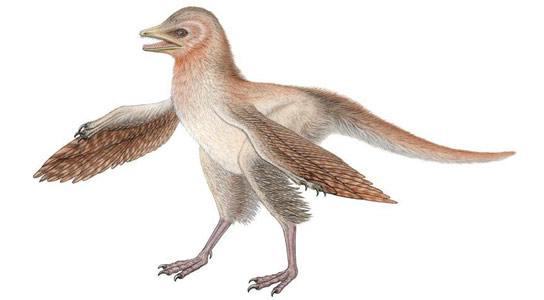
Findings related to the newly discovered ‘bird-dinosaur’ Eosinopteryx suggest that the origin of flight was much more complex than previously thought.
The discovery of a new bird-like dinosaur from the Jurassic period challenges widely accepted theories on the origin of flight.
Co-authored by Dr. Gareth Dyke, Senior Lecturer in Vertebrate Palaeontology at the University of Southampton, the paper describes a new feathered dinosaur about 30 cm (12 in) in length which pre-dates bird-like dinosaurs that birds were long thought to have evolved from.
Over many years, it has become accepted among paleontologists that birds evolved from a group of dinosaurs called theropods from the Early Cretaceous period of Earth’s history, around 120-130 million years ago. Recent discoveries of feathered dinosaurs from the older Middle-Late Jurassic period have reinforced this theory.
The new ‘bird-dinosaur’ Eosinopteryx described in Nature Communications this week provides additional evidence of this effect.
“This discovery sheds further doubt on the theory that the famous fossil Archaeopteryx – or “first bird” as it is sometimes referred to – was pivotal in the evolution of modern birds,” says Dr. Dyke, who is based at the National Oceanography Center, Southampton.
“Our findings suggest that the origin of flight was much more complex than previously thought.”
The fossilized remains found in north-eastern China indicate that, while feathered, this was a flightless dinosaur, because of its small wingspan and a bone structure that would have restricted its ability to flap its wings.
The dinosaur also had toes suited to walking along the ground and fewer feathers on its tail and lower legs, which would have made it easier to run.
Reference: “Reduced plumage and flight ability of a new Jurassic paravian theropod from China” by Pascal Godefroit, Helena Demuynck, Gareth Dyke, Dongyu Hu, François Escuillié and Philippe Claeys, 22 January 2013, Nature Communications.
DOI: 10.1038/ncomms2389
Dr. Gareth Dyke is also the Program Leader for a new one-year MRes in Vertebrate Palaeontology, which offers potential students the chance to study the evolution and anatomy of vertebrates, in order to inform and increase our understanding of the workings of modern-day creatures.
Dr. Dyke’s co-authors are Pascal Godefroit of the Royal Belgian Institute of Natural Sciences, Helena Demuynck of Earth System Science Vrije Universiteit Brussel, Dongyu Hu of Paleontological Institute Shenyang Normal University China and Key Laboratory of Vegetation Ecology Northeast Normal University China, François Escuillié of Eldonia France and Philippe Claeys of Jilin University Geological Museum China.